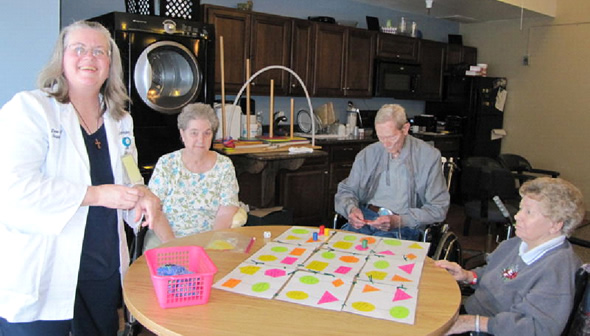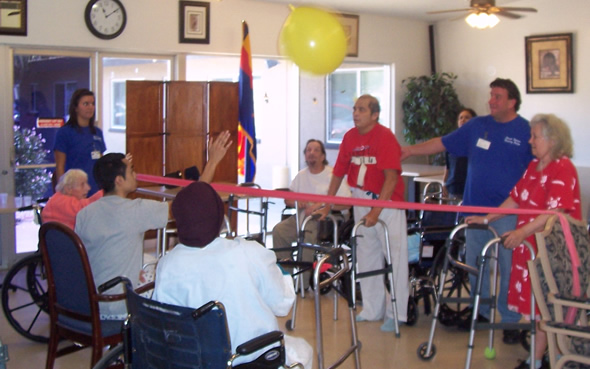As Therapists, we get into this field with aspirations of helping others. Inevitably, we come to learn that the people we are helping also touch our lives. Wellington Place had the opportunity to significantly impact the life of a new resident by providing him with a way to communicate, which he has not had the ability to do in 10 years.
Upon admission, the Wellington team learned that Clint was in an MVA 10 years prior, leaving him with quadriplegia. He had been residing in a local living center since the accident, unable to communicate his needs and wants. Medical records indicated an inability to assess him neurologically and cognitively due to the extent of his deficits. We were not satisfied with this assessment, so we attempted communication with eye blinks. He was 100% successful for 10/10 questions. We could tell from the look in his eyes that he had more to say; so we pressed on, determined to find an augmentative communication device. I brought in an alphabet communication board, and the OT made a splint for his right wrist allowing him to hold an object for pointing.
Over the next several days, the therapy team learned a lot about Clint, including his favorite sports teams. Sadly, we also learned that Clint had also been in a lot of pain over the years. In furtherance of our communication efforts, the nurse asked, “Are you in any pain?” He communicated, “y.e.s. a.r.m.” As tears rolled down his cheek, he spelled “t.h.a.n.k.y.o.u.” We fought tears as well.
His sister was overjoyed with the news that her brother could communicate and sincerely appreciated our efforts. It has been difficult for her to accept that her brother had been alone and unable to communicate for so many years. She shared that he also had a 4-year- old daughter at the time of the accident; she is now 14 years old, and has never been able to communicate with her father.
We were determined to find an augmentative communication device that would allow him to be more independent with use and reduce the amount of physical effort required to use effectively. The support and feedback from our Therapy Resources and Therapists regarding devices available on the market were overwhelming, and very much appreciated.
Ultimately, the communication word boards and the Dynavox EyeMax machine worked best for Clint. This device calibrates his eyes and allows him to find the words he wants to say. As he stares at the words, the machine speaks them.
While waiting anxiously for the new device to arrive, we spent the next eight weeks working on improving oral motor skills for saliva management, as well as speech skills. He was highly motivated and appreciative of the time spent with him. Finally, his “voice” could be heard.
From the day the EyeMax arrived, Clint worked hard with us. He showed us that he was eager to interact and had a lot to say! Clint asked about seeing his daughter, and wanted to tell his sister he loved her. He told the Dynavox Representative she was pretty, and he shared that he missed dancing, among other things. He told his SLP he loved her too.
We videotaped treatments to show his sister and physician; both were elated to see the progress made by Clint. The decision was made to allow him to reside at Wellington Place where he can continue to prosper with his newfound freedom.
It took an Ensign village to make a difference in this person’s life; Wellington’s team is thankful for the support provided by so many people. Clint tells us we changed his life for the better; and we tell him he has touched our hearts forever.




